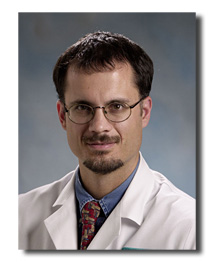Case History of a Family with GIST
 GSI asked Jonathan C. Trent, M.D. Ph.D. several questions about the 2006 ASCO poster on familial GIST presented by a group of researchers from M.D. Anderson. Dr. Trent is a Medical oncologist and GIST expert at Sylvester Cancer Center in Miami, Florida. GIST is one of his main interests in his practice and in his research.
GSI asked Jonathan C. Trent, M.D. Ph.D. several questions about the 2006 ASCO poster on familial GIST presented by a group of researchers from M.D. Anderson. Dr. Trent is a Medical oncologist and GIST expert at Sylvester Cancer Center in Miami, Florida. GIST is one of his main interests in his practice and in his research.
Familial gastrointestinal stromal tumor with homo-/hemizygous kit exon 11 deletion: Genotypic, histopathologic, radiographic, and therapeutic findings.
Abstract No: 9527
Citation: Journal of Clinical Oncology, 2006 ASCO Annual Meeting Proceedings Part I. Vol 24, No. 18S (June 20 Supplement), 2006: 9527
Author(s): E. P. Kleinbaum, L. L. Chen, A. Lazar, L. Strong, W. Zhang, H. Choi, R. Benjamin, S. Patel, J. C. Trent
Abstract: Background: Germ-line mutations in the kit receptor tyrosine kinase gene have been described in families with a propensity to develop gastrointestinal stromal tumor (GIST). We describe a large kindred with multiple individuals with GIST and describe the genotype, clinical presentation, radiographic imaging, surgical findings, imatinib-sensitivity, and histopathologic appearance. Patients and Methods: A large kindred with multiple GISTs were identified after the proband patient was referred to our institution. The history of each affected and unaffected family member was obtained in person or via telephone. A medical questionnaire was sent to family members and appropriate medical records, tumor tissue and radiographic imaging was obtained. Histopathologic specimens from four of the family members with GIST was obtained, the diagnosis confirmed and three specimens were used to sequence kit exon 9, 11, 13, 15 and 17. Results: Fifteen members were identified in this family with histopathologic diagnosis of GIST or probable GIST. Surgical findings revealed multiple tumors arising from the submucosa of the small intestine. Histopathology revealed microscopic proliferation of the myenteric plexus with areas of microscopic tumor nodularity. Four patients in this kindred were treated with imatinib and had radiographic and clinical evidence of therapeutic benefit. A deletion of codon 579 in exon 11 of the kit gene was identified in tumor and normal tissue of this family. Evaluation of one GIST revealed loss of heterozygosity in kit exon 11 suggesting a homozygous mutation or loss of the wild-type locus. Conclusion: This study describes a kindred with a propensity to develop GIST in association with hyperpigmentation and melanocytic nevi, but not dysphagia. The germline deletion of codon 579 appears to confer proliferation and nodularity of the myenteric plexus, synchronous tumors at presentation, a metastatic phenotype, and in vivo sensitivivity to imatinib therapy.
Dr. Trent has kindly shared a file of the poster so that you can view it as a pdf file using the free Adobe Reader software. Using the Adobe Reader you can view sections of the poster at magnification to read it easily and view the details of the figures.
CLICK HERE TO OPEN THE PDF OF THE POSTER.
After opening the poster pdf, change ZOOM to at least 50% to view sections of the poster in detail.
QUESTIONS answered by Dr. Trent
1. GIST that "runs in the family" is caused by a germline mutation that affects all the cells in the body. How could such a germline mutation get started?
No one knows.
2. Figure 1 of the poster, which illustrates the studied members of the family, shows all the individuals in the latest two generations as "unaffected" even though some did have an affected parent. Does this mean
that none of these individuals carry the mutation, or merely that none have developed any symptoms so far? What is the chance that a child will inherit the mutant gene in this family?
The chance of inheriting the mutation is 50/50. "Unaffected" means the individuals do not currently have GIST. They may get GIST one day.
3. How is the pattern of growth of multiple GISTs in familial GIST different from non-familial sporadic GIST cases?
Each individual GIST in the "multiple" GISTs is like a new, separate primary tumor. Any of these may metastasize.

